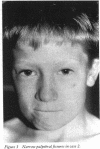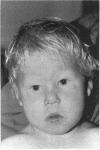Abstract
DiGeorge syndrome was diagnosed in an infant who had an interrupted aortic arch, hypoparathyroidism, and low T lymphocyte numbers. Two siblings had heart defects that are not commonly described in DiGeorge syndrome (a membranous ventricular septal defect and coarctation of the aorta respectively). These siblings did not have evidence of thymic dysfunction or hypoparathyroidism. Chromosome analysis showed that the mother, whose cardiovascular examination was normal, and her three offspring with heart defects had a 22q11 interstitial deletion, which was confirmed by molecular analysis. This family suggests that 22q11 deletions can cause apparently isolated heart defects and that the range of these defects may be wider than previously recognised. Once the genes that are deleted in this family are characterised they will be useful candidate genes in the investigation of isolated cardiac malformations.
Full text
PDF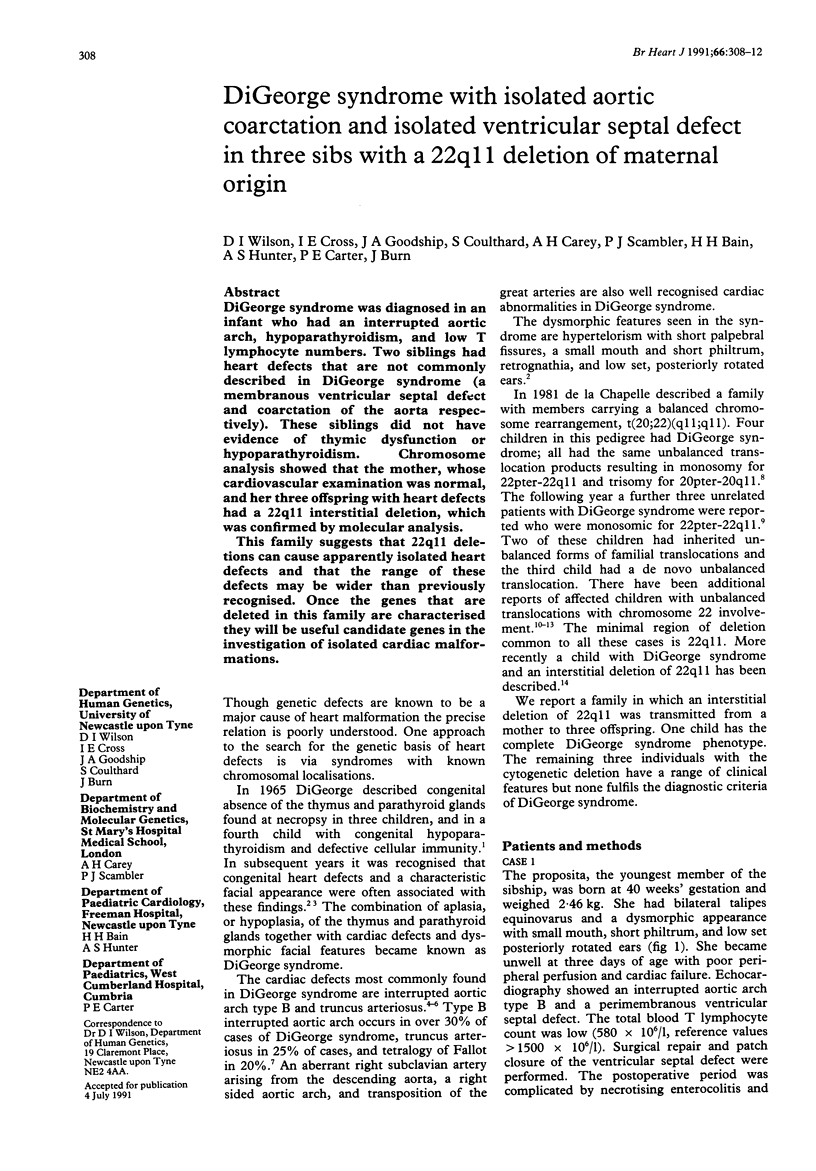
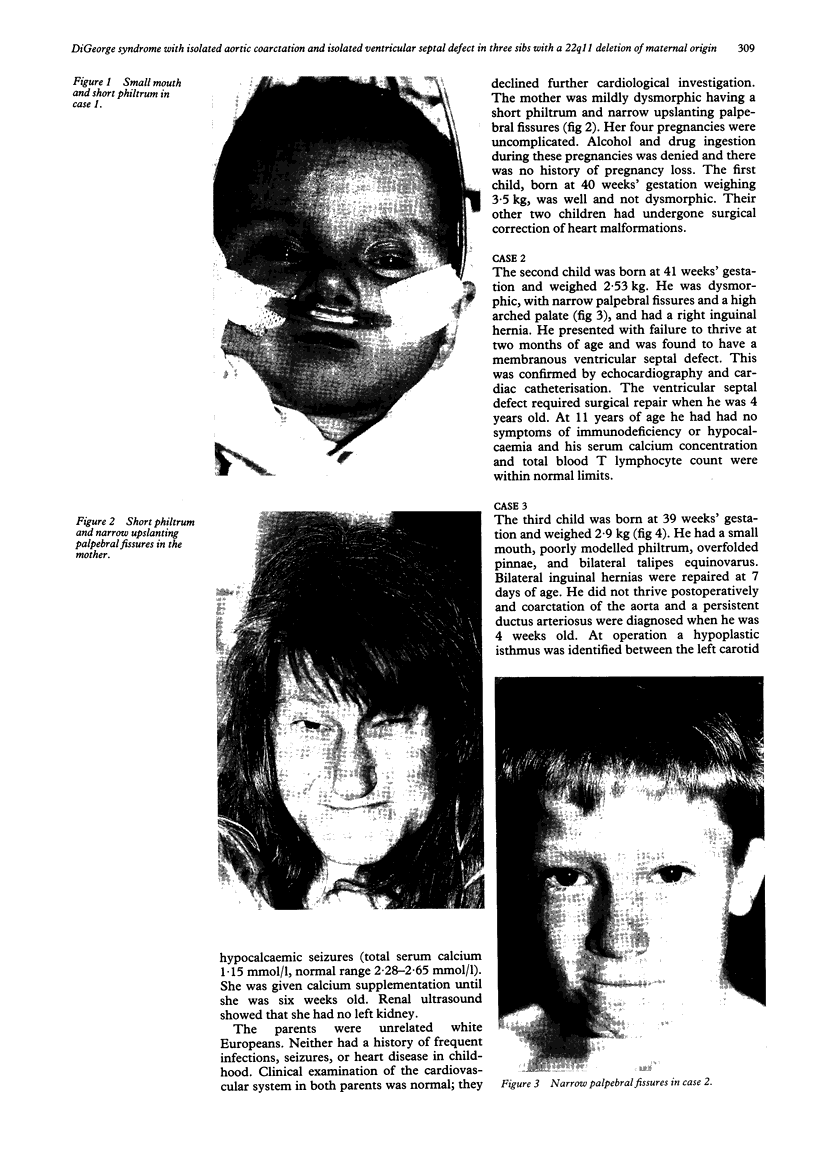
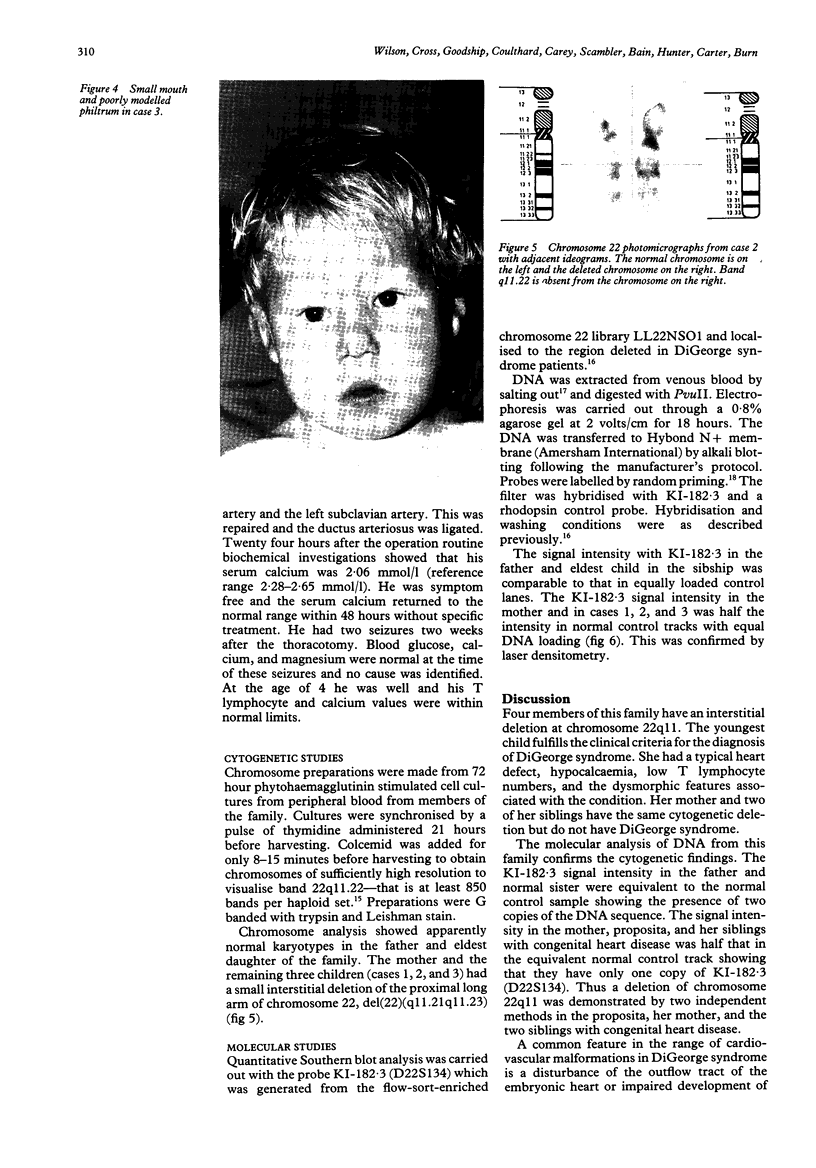
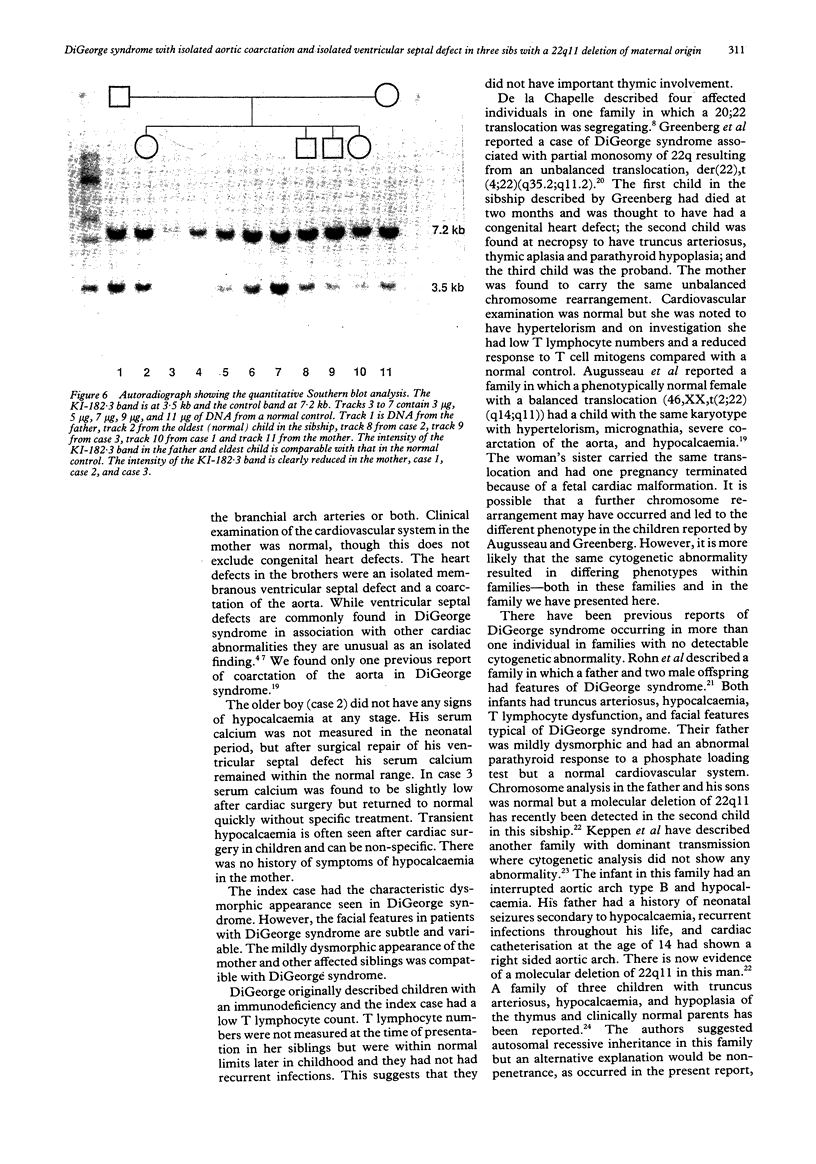
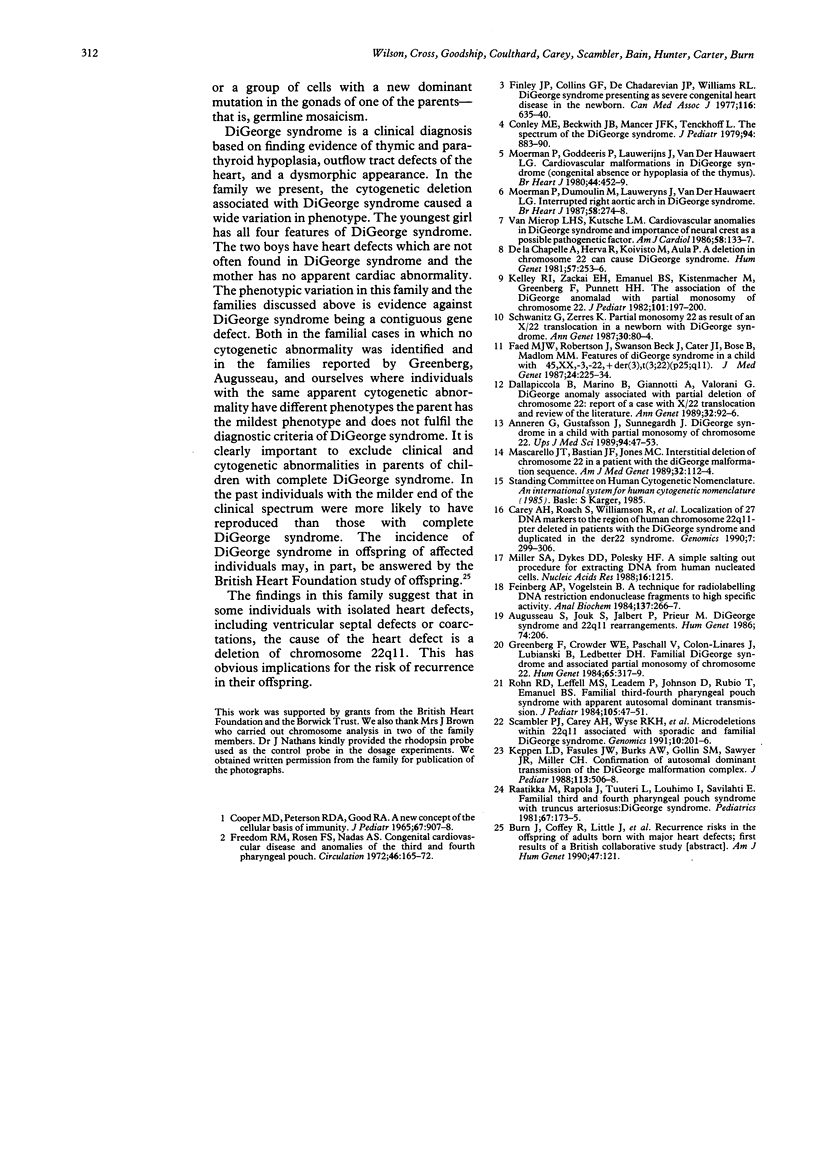
Images in this article
Selected References
These references are in PubMed. This may not be the complete list of references from this article.
- Annerén G., Gustafsson J., Sunnegårdh J. DiGeorge syndrome in a child with partial monosomy of chromosome 22. Ups J Med Sci. 1989;94(1):47–53. doi: 10.3109/03009738909179246. [DOI] [PubMed] [Google Scholar]
- Augusseau S., Jouk S., Jalbert P., Prieur M. DiGeorge syndrome and 22q11 rearrangements. Hum Genet. 1986 Oct;74(2):206–206. doi: 10.1007/BF00282098. [DOI] [PubMed] [Google Scholar]
- Carey A. H., Roach S., Williamson R., Dumanski J. P., Nordenskjold M., Collins V. P., Rouleau G., Blin N., Jalbert P., Scambler P. J. Localization of 27 DNA markers to the region of human chromosome 22q11-pter deleted in patients with the DiGeorge syndrome and duplicated in the der22 syndrome. Genomics. 1990 Jul;7(3):299–306. doi: 10.1016/0888-7543(90)90161-m. [DOI] [PubMed] [Google Scholar]
- Conley M. E., Beckwith J. B., Mancer J. F., Tenckhoff L. The spectrum of the DiGeorge syndrome. J Pediatr. 1979 Jun;94(6):883–890. doi: 10.1016/s0022-3476(79)80207-3. [DOI] [PubMed] [Google Scholar]
- Dallapiccola B., Marino B., Giannotti A., Valorani G. Digeorge anomaly associated with partial deletion of chromosome 22. Report of a case with X/22 translocation and review of the literature. Ann Genet. 1989;32(2):92–96. [PubMed] [Google Scholar]
- Faed M. J., Robertson J., Beck J. S., Cater J. I., Bose B., Madlom M. M. Features of di George syndrome in a child with 45,XX,-3,-22,+der(3),t(3;22)(p25;q11). J Med Genet. 1987 Apr;24(4):225–227. doi: 10.1136/jmg.24.4.225. [DOI] [PMC free article] [PubMed] [Google Scholar]
- Feinberg A. P., Vogelstein B. "A technique for radiolabeling DNA restriction endonuclease fragments to high specific activity". Addendum. Anal Biochem. 1984 Feb;137(1):266–267. doi: 10.1016/0003-2697(84)90381-6. [DOI] [PubMed] [Google Scholar]
- Finley J. P., Collins G. F., de Chadarévian J. P., Williams R. L. DiGeorge syndrome presenting as severe congenital heart disease in the newborn. Can Med Assoc J. 1977 Mar 19;116(6):635–640. [PMC free article] [PubMed] [Google Scholar]
- Freedom R. M., Rosen F. S., Nadas A. S. Congenital cardiovascular disease and anomalies of the third and fourth pharyngeal pouch. Circulation. 1972 Jul;46(1):165–172. doi: 10.1161/01.cir.46.1.165. [DOI] [PubMed] [Google Scholar]
- Greenberg F., Crowder W. E., Paschall V., Colon-Linares J., Lubianski B., Ledbetter D. H. Familial DiGeorge syndrome and associated partial monosomy of chromosome 22. Hum Genet. 1984;65(4):317–319. doi: 10.1007/BF00291554. [DOI] [PubMed] [Google Scholar]
- Kelley R. I., Zackai E. H., Emanuel B. S., Kistenmacher M., Greenberg F., Punnett H. H. The association of the DiGeorge anomalad with partial monosomy of chromosome 22. J Pediatr. 1982 Aug;101(2):197–200. doi: 10.1016/s0022-3476(82)80116-9. [DOI] [PubMed] [Google Scholar]
- Keppen L. D., Fasules J. W., Burks A. W., Gollin S. M., Sawyer J. R., Miller C. H. Confirmation of autosomal dominant transmission of the DiGeorge malformation complex. J Pediatr. 1988 Sep;113(3):506–508. doi: 10.1016/s0022-3476(88)80640-1. [DOI] [PubMed] [Google Scholar]
- Kishi K., Yasuda T., Ikehara Y., Sawazaki K., Sato W., Iida R. Human serum deoxyribonuclease I (DNase I) polymorphism: pattern similarities among isozymes from serum, urine, kidney, liver, and pancreas. Am J Hum Genet. 1990 Jul;47(1):121–126. [PMC free article] [PubMed] [Google Scholar]
- Mascarello J. T., Bastian J. F., Jones M. C. Interstitial deletion of chromosome 22 in a patient with the DiGeorge malformation sequence. Am J Med Genet. 1989 Jan;32(1):112–114. doi: 10.1002/ajmg.1320320124. [DOI] [PubMed] [Google Scholar]
- Miller S. A., Dykes D. D., Polesky H. F. A simple salting out procedure for extracting DNA from human nucleated cells. Nucleic Acids Res. 1988 Feb 11;16(3):1215–1215. doi: 10.1093/nar/16.3.1215. [DOI] [PMC free article] [PubMed] [Google Scholar]
- Moerman P., Dumoulin M., Lauweryns J., Van der Hauwaert L. G. Interrupted right aortic arch in DiGeorge syndrome. Br Heart J. 1987 Sep;58(3):274–278. doi: 10.1136/hrt.58.3.274. [DOI] [PMC free article] [PubMed] [Google Scholar]
- Moerman P., Goddeeris P., Lauwerijns J., Van der Hauwaert L. G. Cardiovascular malformations in DiGeorge syndrome (congenital absence of hypoplasia of the thymus). Br Heart J. 1980 Oct;44(4):452–459. doi: 10.1136/hrt.44.4.452. [DOI] [PMC free article] [PubMed] [Google Scholar]
- Raatikka M., Rapola J., Tuuteri L., Louhimo I., Savilahti E. Familial third and fourth pharyngeal pouch syndrome with truncus arteriosus: DiGeorge syndrome. Pediatrics. 1981 Feb;67(2):173–175. [PubMed] [Google Scholar]
- Rohn R. D., Leffell M. S., Leadem P., Johnson D., Rubio T., Emanuel B. S. Familial third-fourth pharyngeal pouch syndrome with apparent autosomal dominant transmission. J Pediatr. 1984 Jul;105(1):47–51. doi: 10.1016/s0022-3476(84)80355-8. [DOI] [PubMed] [Google Scholar]
- Scambler P. J., Carey A. H., Wyse R. K., Roach S., Dumanski J. P., Nordenskjold M., Williamson R. Microdeletions within 22q11 associated with sporadic and familial DiGeorge syndrome. Genomics. 1991 May;10(1):201–206. doi: 10.1016/0888-7543(91)90501-5. [DOI] [PubMed] [Google Scholar]
- Schwanitz G., Zerres K. Partial monosomy 22 as result of an X/22 translocation in a newborn with DiGeorge syndrome. Ann Genet. 1987;30(2):80–84. [PubMed] [Google Scholar]
- Van Mierop L. H., Kutsche L. M. Cardiovascular anomalies in DiGeorge syndrome and importance of neural crest as a possible pathogenetic factor. Am J Cardiol. 1986 Jul 1;58(1):133–137. doi: 10.1016/0002-9149(86)90256-0. [DOI] [PubMed] [Google Scholar]
- de la Chapelle A., Herva R., Koivisto M., Aula P. A deletion in chromosome 22 can cause DiGeorge syndrome. Hum Genet. 1981;57(3):253–256. doi: 10.1007/BF00278938. [DOI] [PubMed] [Google Scholar]





